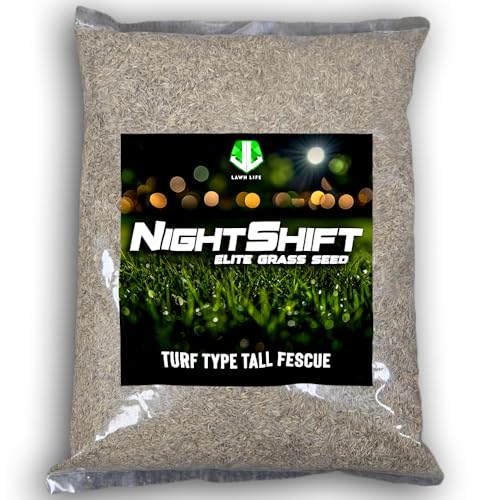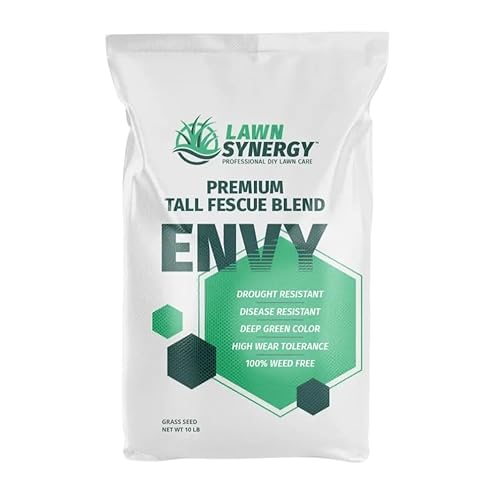If you’re a homeowner in Wisconsin, you know how important it is to have a lush, green lawn. But with so many different types of grass to choose from, it can be challenging to determine which one is right for your lawn. In this article, we’ll explore the best grass types for lawns in Wisconsin, taking into account the state’s unique climate and growing conditions.

Wisconsin’s climate can be challenging for growing grass, with hot summers and cold winters. But with the right grass type and proper care, you can achieve a beautiful, healthy lawn. We’ll discuss the key factors to consider when selecting a grass type, including shade tolerance, drought tolerance, and maintenance requirements. We’ll also highlight some of the most popular grass types for Wisconsin lawns, including Kentucky bluegrass, perennial ryegrass, and tall fescue.
Creating a lush green lawn in Wisconsin takes time and effort, but it’s well worth it. By choosing the right grass type and following best practices for planting and maintenance, you can enjoy a beautiful lawn that adds value and curb appeal to your home. Let’s get started!
Key Takeaways
- Choosing the right grass type is crucial for a healthy lawn in Wisconsin’s climate.
- Kentucky bluegrass, perennial ryegrass, and tall fescue are popular grass types for Wisconsin lawns.
- Proper planting and maintenance are essential for creating a lush green lawn.
Understanding Wisconsin’s Climate

https://www.youtube.com/watch?v=GILMroxp8N4&embed=true
If you’re a Wisconsin resident, you know that the state has a humid continental climate with long, cold winters and short, hot summers. The climate is influenced by the Great Lakes, which moderate temperatures and provide ample moisture to the state.
Wisconsin winters are notoriously cold, with average temperatures ranging from 10°F to 30°F (-12°C to -1°C) in January. Snowfall is common, with some areas receiving up to 100 inches of snowfall annually. This means that any grass types you choose for your lawn must be able to withstand harsh winter conditions.
During the summer months, temperatures can reach up to 85°F (29°C) in July, with high humidity levels. This means that grass types must also be able to tolerate hot, humid conditions.
When it comes to grass types for Wisconsin lawns, you’ll want to choose cool-season grasses that can thrive in the state’s climate. Some of the best grass types for Wisconsin include:
- Kentucky Bluegrass: This grass type is a popular choice for Wisconsin lawns. It can handle cold winters and hot summers and is known for its deep green color and fine texture.
- Tall Fescue: Tall fescue is a deep-rooted grass type that can survive harsh winter conditions. It’s also drought-tolerant, making it a great choice for Wisconsin summers.
- Perennial Ryegrass: This grass type is highly drought-tolerant and can handle hot, humid summers. It’s also known for its fine texture and deep green color.
- Fine Fescue: Fine fescues are a group of grass types that can handle cold winters and hot summers. They are also shade-tolerant, making them a great choice for lawns with trees or other obstacles that create shade.
When choosing a grass type for your Wisconsin lawn, consider factors such as soil type, sun exposure, and water availability. Proper preparation of the soil by adding organic matter and fertilizer is crucial to obtaining good results. Regular watering provides necessary moisture to germinate the seedlings correctly.
Grass Types for Wisconsin Lawns
https://www.youtube.com/watch?v=U12JPX-2Wjo&embed=true
When it comes to choosing the best grass types for your Wisconsin lawn, you have several options to consider. The two main categories of grasses are cool-season and warm-season. Each type of grass has its own unique characteristics that make it suitable for different environments and conditions.
Cool-Season Grasses
Cool-season grasses grow best in cooler temperatures, making them an ideal choice for Wisconsin’s climate. These grasses are known for their ability to grow in the spring and fall, and they can tolerate some cold temperatures. Here are some cool-season grass varieties that you can consider for your Wisconsin lawn:
- Kentucky Bluegrass: This is the most popular grass type in Wisconsin and is known for its fine texture, rich green color, and the ability to withstand poor drainage conditions. Kentucky bluegrass is also an ideal fit in yards with trees, as it is tolerant of partial sunlight.
- Fine Fescues: Fine fescues are a group of grasses that are known for their fine texture and ability to grow in shade. These grasses are drought-tolerant and require less fertilizer than other grass types, making them a great choice for low-maintenance lawns.
- Perennial Ryegrass: Perennial ryegrass is a fast-growing grass that is often used in seed mixtures with other cool-season grasses. It has a fine texture and is known for its ability to germinate quickly.
Warm-Season Grasses
Warm-season grasses are best suited for areas with hot summers and mild winters. These grasses typically go dormant in the winter and turn brown, but they can thrive in the summer heat. Here are some warm-season grass varieties that you can consider for your Wisconsin lawn:
- Bermudagrass: Bermudagrass is a popular warm-season grass that is known for its ability to tolerate heat and drought. It has a fine texture and is often used on golf courses and athletic fields.
- Zoysia Grass: Zoysia grass is a slow-growing grass that is known for its ability to tolerate heat and drought. It has a coarse texture and is often used on lawns and golf courses.
- Tall Fescue: Tall fescue is a cool-season grass that can also grow in warmer temperatures. It has a coarse texture and is known for its ability to tolerate heat and drought.
When choosing the best grass type for your lawn, it’s important to consider factors such as the amount of sunlight your lawn receives, the soil type, and the amount of foot traffic your lawn gets. Native grasses can also be a great option for Wisconsin lawns, as they are adapted to the local climate and require less maintenance.
Key Factors for Grass Selection
https://www.youtube.com/watch?v=9COKtjaLyhE&embed=true
When selecting the best grass types for your Wisconsin lawn, it is important to consider several key factors to ensure optimal growth and appearance. Here are some of the most important factors to keep in mind:
Sun and Shade Tolerance
Different grass types have varying levels of sun and shade tolerance. For areas of your lawn that receive full sun, consider grass types such as Bermudagrass or Kentucky Bluegrass. For areas that receive partial shade, consider Fine Fescue or Perennial Ryegrass. If your lawn is mostly shaded, you may want to consider a grass type such as Creeping Red Fescue or Chewings Fescue.
Soil Conditions
The type of soil in your lawn can greatly impact the growth and appearance of your grass. It is important to consider factors such as soil type, pH, temperature, and preparation when selecting the best grass type for your lawn. For example, Kentucky Bluegrass grows best in well-draining soil with a pH level between 6.0 and 7.0, while Fine Fescue can tolerate a wider range of soil types and pH levels.
Foot Traffic Tolerance
If your lawn experiences a lot of foot traffic, it is important to select a grass type that can withstand the wear and tear. Kentucky Bluegrass and Tall Fescue are both good options for high-traffic areas, as they have strong root systems and can recover quickly from damage.
Maintenance Needs
Different grass types have varying maintenance needs, so it is important to select a grass type that fits your lifestyle and lawn care habits. For example, Kentucky Bluegrass requires frequent mowing and fertilization, while Fine Fescue is more low-maintenance and can tolerate infrequent mowing and fertilization.
By considering these key factors when selecting the best grass type for your Wisconsin lawn, you can ensure optimal growth, appearance, and longevity.
Popular Grass Types in Wisconsin
https://www.youtube.com/watch?v=XkeX3v48jVs&embed=true
When it comes to choosing the right grass type for your lawn in Wisconsin, there are a few options that are more popular than others. Here are some of the most commonly used grass types in Wisconsin.
« Best Grass Types for Lawns in West Virginia: A Friendly Guide Best Grass Types for Lawns in Wyoming: A Guide to Choosing the Right Grass for Your Yard »
Kentucky Bluegrass
Kentucky Bluegrass is a cool-season grass that is well-suited for Wisconsin’s climate. It is a popular choice for lawns because it has a fine texture and a dark green color. Kentucky Bluegrass is also known for its ability to self-repair, making it a great choice for high-traffic areas. It does require regular watering and fertilization to maintain its lush appearance.
Tall Fescue
Tall Fescue is another cool-season grass that is commonly used in Wisconsin lawns. It has a coarser texture than Kentucky Bluegrass but is more tolerant of drought and shade. Tall Fescue is also known for its deep root system, which helps it to withstand heavy foot traffic and drought conditions. It is a good choice for homeowners who want a low-maintenance lawn.
Fine Fescue
Fine Fescue is a group of cool-season grasses that includes Red Fescue, Chewings Fescue, Hard Fescue, and Sheep Fescue. These grasses are known for their fine texture and shade tolerance. They are often used in shady areas where other grass types struggle to grow. Fine Fescues are also low-maintenance and require less water than other grass types.
Perennial Ryegrass
Perennial Ryegrass is a cool-season grass that is often used in Wisconsin lawns as a companion grass with Kentucky Bluegrass or Fine Fescue. It has a fine texture and a bright green color, making it a good choice for ornamental lawns. Perennial Ryegrass is also known for its quick germination and ability to establish quickly.
Overall, the best grass types for Wisconsin lawns are cool-season grasses like Kentucky Bluegrass, Tall Fescue, Fine Fescue, and Perennial Ryegrass. Each type has its own unique characteristics and benefits, so it’s important to choose the one that best fits your needs and preferences. When selecting a grass type, consider factors like your lawn’s sun exposure, soil type, and intended use.
Planting and Growing Your Lawn
https://www.youtube.com/watch?v=khcjQvABIPI&embed=true
Growing a lush and healthy lawn in Wisconsin requires careful planning and execution. By following the right steps, you can have a beautiful lawn that will be the envy of your neighborhood. Here are some tips to help you plant and grow your lawn successfully.
Best Time to Plant
The best time to plant grass seed in Wisconsin is in the fall, between mid-August and mid-September. This is when the soil is still warm from the summer heat, but the cooler temperatures and higher rainfall in the fall provide ideal conditions for seed germination. Spring is also a good time to plant, but it’s important to avoid planting too early, as the soil may still be too cold for germination.
Seeding Your Lawn
When seeding your lawn, it’s important to choose the right grass seed for your specific needs. Kentucky bluegrass is the most common grass grown in Wisconsin, but fine fescue and bentgrass are also good options. Make sure to prepare the soil properly by removing any debris, rocks, or weeds, and then rake the soil to create a smooth surface. Spread the seed evenly over the soil, and then cover lightly with soil, straw, or mulch. Keep the soil moist by watering regularly, but be careful not to overwater, as this can lead to fungal growth.
Watering and Fertilizing
Watering and fertilizing are essential for maintaining a healthy lawn. When watering, it’s important to water deeply and infrequently, rather than shallow and frequently. This will encourage deeper root growth and help the grass to be more drought-resistant. Fertilizing should be done in the spring and fall, using a slow-release fertilizer that provides a balance of nitrogen, phosphorus, and potassium. Over-fertilizing can lead to excessive growth and thatch buildup, so be sure to follow the instructions carefully.
By following these tips, you can successfully plant and grow a beautiful lawn in Wisconsin. Remember to choose the right grass seed, plant at the right time, water and fertilize properly, and maintain your lawn regularly for best results.
Maintaining a Healthy Lawn
https://www.youtube.com/watch?v=Ou_NICup0kM&embed=true
To keep your lawn looking its best, it’s important to maintain it properly. This means mowing and aerating regularly, dealing with drought when it occurs, and taking steps to prevent disease. Here are some tips for maintaining a healthy lawn in Wisconsin.
Mowing and Aeration
Mowing your lawn regularly is essential to keeping it healthy. Make sure to keep your mower blades sharp and mow at the appropriate height for your grass type. For most grasses in Wisconsin, a mowing height of 2.5 to 3 inches is recommended. This helps to promote deep root growth and a healthy lawn.
In addition to mowing, aerating your lawn can also help to keep it healthy. Aeration involves removing small plugs of soil from your lawn, which helps to improve soil drainage and air circulation. This can help to prevent soil compaction and promote healthy root growth.
Dealing with Drought
Drought can be a major challenge for lawns in Wisconsin, especially during the hot, dry summer months. To help your lawn survive drought conditions, it’s important to choose grass types that are drought-tolerant or drought-resistant.
Some of the best grass types for drought-prone areas include tall fescue, fine fescue, and Kentucky bluegrass. These grasses have deep root systems and can survive for longer periods without water.
If you do experience drought conditions, it’s important to water your lawn deeply and infrequently. This helps to promote deep root growth and can help your lawn survive periods of drought.
Preventing Disease
Disease can be a major problem for lawns in Wisconsin, especially during periods of high humidity. To prevent disease, it’s important to choose grass types that are resistant to common diseases in your area.
Some grass types, such as Kentucky bluegrass, are more susceptible to disease than others. To prevent disease, make sure to water your lawn deeply and infrequently, avoid over-fertilizing, and keep your lawn well-maintained.
By following these tips, you can help to maintain a healthy lawn in Wisconsin. Remember to mow and aerate regularly, choose drought-tolerant grass types, and take steps to prevent disease.
Creating a Lush Green Lawn
https://www.youtube.com/watch?v=fHn8WMaHGmg&embed=true
Everyone wants a lush green lawn that enhances the beauty of their property. A well-maintained lawn not only adds to the aesthetic appeal but also increases the value of your property. Here are some tips to help you create a lush green lawn in Wisconsin:
Choose the Right Grass Type
Wisconsin’s climate is well-suited for cool-season grasses such as Kentucky bluegrass, fescue, and ryegrass. These grasses thrive in cooler temperatures and can withstand harsh winters. Kentucky bluegrass is the most popular choice for Wisconsin lawns due to its ability to grow in full sun and partial shade. Fescue is another great option for shady areas, while ryegrass can be used to overseed during fall to keep your lawn green during winter.
Soil Preparation
The soil is the foundation of a healthy lawn. Before planting grass, make sure to prepare the soil properly. The soil should be well-drained, loose, and have a pH level between 6.0 and 7.0. You can add organic matter such as compost or peat moss to improve soil quality. It’s also important to remove any rocks, debris, or weeds from the soil before planting.
Proper Watering
Proper watering is essential for a lush green lawn. Water your lawn deeply and infrequently. This means watering your lawn once or twice a week, but making sure to give it enough water to penetrate the soil to a depth of 6-8 inches. Avoid watering your lawn during the hottest part of the day, as this can cause the water to evaporate quickly. It’s also important to water your lawn in the morning to prevent fungal growth.
Fertilization
Fertilization is essential to keep your lawn healthy and green. Apply fertilizer in spring and fall to provide the necessary nutrients to your lawn. Make sure to choose a fertilizer that is specifically formulated for your grass type and soil conditions. Over-fertilizing can cause more harm than good, so make sure to follow the instructions on the package.
By following these tips, you can create a lush green lawn that will enhance the beauty of your property. Remember to choose the right grass type, prepare the soil properly, water your lawn deeply and infrequently, and fertilize your lawn regularly. With a little effort and care, you can enjoy a beautiful lawn all year round.
Wisconsin Lawn Care for Homeowners
https://www.youtube.com/watch?v=flJfBOpHwc0&embed=true
As a homeowner in Wisconsin, maintaining a healthy lawn is important for both the appearance of your property and the environment. Here are some tips to help you care for your lawn:
Mowing
Mowing your lawn regularly is essential to keep it healthy. During the growing season, it is recommended to mow your lawn every 1-2 weeks. Set your mower blades to a height of 2 1/2 to 3 1/2 inches to ensure that the grass is not cut too short, which can lead to stress and damage.
Watering
Watering your lawn is important to keep it healthy, especially during hot and dry weather. It is recommended to water your lawn deeply once a week rather than shallowly every day. This will encourage the roots to grow deeper and make your lawn more drought-resistant. If you live in Madison, Milwaukee, or Green Bay, be sure to follow any local watering restrictions.
Fertilizing
Fertilizing your lawn is important to provide it with the nutrients it needs to grow strong and healthy. It is recommended to fertilize your lawn twice a year, in the spring and fall. Choose a fertilizer that is appropriate for your grass type and follow the instructions carefully.
Choosing the Right Grass Type
Choosing the right grass type for your lawn is important to ensure that it thrives in Wisconsin’s climate. Kentucky bluegrass is a popular choice for homeowners in Wisconsin as it is well-suited to the state’s cool and humid climate. Other grass types that do well in Wisconsin include tall fescue and ryegrass. Be sure to choose a grass type that is appropriate for the amount of sun and shade your lawn receives.
By following these tips, you can help ensure that your lawn stays healthy and beautiful all year round.
Conclusion

Choosing the best grass type for your lawn in Wisconsin can be a daunting task, but it doesn’t have to be. By considering factors such as soil type, sun exposure, and climate, you can find the perfect grass type for your lawn.
Kentucky Bluegrass is the best overall grass for Wisconsin lawns, with its fine texture and deep green color. It is perfect for creating a lush and attractive green space. However, if you have a lawn that is exposed to full sun, Bermudagrass may be a better option for you. It is a hardy grass that can withstand high temperatures and drought.
If you have a lawn that is shaded, Ryegrass is the best grass type for you. It is a cool-season grass that thrives in shaded areas and has a high tolerance for traffic. If you want a grass type that can survive deep freezes, Tall Fescue is the way to go. It is a hardy grass that can withstand cold temperatures and drought.
When choosing the best grass type for your lawn, it is important to consider the maintenance requirements of each grass type. Some grass types require more maintenance than others. For example, Kentucky Bluegrass requires frequent watering and fertilization, while Bermudagrass requires less water and fertilizer.
Ultimately, the best grass type for your lawn will depend on your specific needs and requirements. Consider the factors mentioned above and choose the grass type that will work best for you. With the right grass type, you can create a beautiful and healthy lawn that will be the envy of your neighborhood.
Frequently Asked Questions
https://www.youtube.com/watch?v=JaPNiwEm32w&embed=true
What are some recommended grass types for lawns in Wisconsin?
When it comes to choosing the best grass types for your Wisconsin lawn, it’s important to consider the climate and soil conditions. Some of the most recommended grass types for Wisconsin lawns include Kentucky Bluegrass, Tall Fescue, and Ryegrass. These grasses are known for their durability, resilience, and ability to withstand the harsh winter weather conditions in Wisconsin.
What are the advantages of planting Kentucky Bluegrass in Wisconsin?
Kentucky Bluegrass is the most popular grass type for lawns in Wisconsin, and for good reason. This grass type is known for its lush, green appearance and ability to thrive in the cool, humid climate of the Midwest. Kentucky Bluegrass is also highly resistant to disease and pests, making it a low-maintenance option for homeowners.
Is Bermuda grass a good option for lawns in Wisconsin?
Bermuda grass is not typically recommended for lawns in Wisconsin, as it is a warm-season grass that is better suited to warmer climates. This grass type requires a lot of sunlight and warm temperatures to grow properly, which can be difficult to achieve in Wisconsin’s cooler climate.
What are some tall ornamental grasses that grow well in Wisconsin?
If you’re looking for tall ornamental grasses to add texture and interest to your Wisconsin lawn, some great options include Miscanthus, Switchgrass, and Big Bluestem. These grasses are known for their height and unique appearance, and they are also highly resilient and easy to care for.
When is the best time to plant grass seed in Wisconsin?
The best time to plant grass seed in Wisconsin is typically in the late summer or early fall, between August 15 and September 15. This is when the soil is still warm enough to promote seed germination, but the cooler temperatures and increased rainfall provide the ideal growing conditions for new grass.
What are the most durable and easiest to grow grass types for lawns in the Midwest?
Some of the most durable and easiest to grow grass types for lawns in the Midwest include Kentucky Bluegrass, Tall Fescue, and Ryegrass. These grasses are known for their resilience and ability to withstand harsh weather conditions, making them a great choice for homeowners who want a low-maintenance lawn that looks great year-round.
















